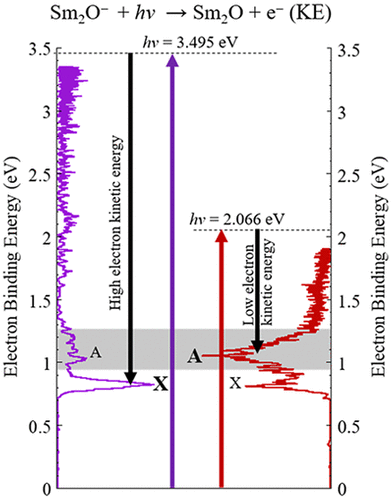当前位置:
X-MOL 学术
›
Acc. Chem. Res.
›
论文详情
Our official English website, www.x-mol.net, welcomes your
feedback! (Note: you will need to create a separate account there.)
Exceptionally Complex Electronic Structures of Lanthanide Oxides and Small Molecules.
Accounts of Chemical Research ( IF 16.4 ) Pub Date : 2019-11-08 , DOI: 10.1021/acs.accounts.9b00474 Jarrett L Mason 1 , Hassan Harb 2 , Josey E Topolski 1 , Hrant P Hratchian 2 , Caroline Chick Jarrold 1
Accounts of Chemical Research ( IF 16.4 ) Pub Date : 2019-11-08 , DOI: 10.1021/acs.accounts.9b00474 Jarrett L Mason 1 , Hassan Harb 2 , Josey E Topolski 1 , Hrant P Hratchian 2 , Caroline Chick Jarrold 1
Affiliation

|
Lanthanide (Ln) oxide clusters and molecular systems provide a bottom-up look at the electronic structures of the bulk materials because of close parallels in the patterns of Ln 4fN subshell occupancy between the molecular and bulk Ln2O3 size limits. At the same time, these clusters and molecules offer a challenge to the theory community to find appropriate and robust treatments for the 4fN patterns across the Ln series. Anion photoelectron (PE) spectroscopy provides a powerful experimental tool for studying these systems, mapping the energies of the ground and low-lying excited states of the neutral relative to the initial anion state, providing spectroscopic patterns that reflect the Ln 4fN occupancy. In this Account, we review our anion PE spectroscopic and computational studies on a range of small lanthanide molecules and cluster species. The PE spectra of LnO- (Ln = Ce, Pr, Sm, Eu) diatomic molecules show spectroscopic signatures associated with detachment of an electron from what can be described as a diffuse Ln 6s-like orbital. While the spectra of all four diatomics share this common transition, the fine structure in the transition becomes more complex with increasing 4f occupancy. This effect reflects increased coupling between the electrons occupying the corelike 4f and diffuse 6s orbitals with increasing N. Understanding the PE spectra of these diatomics sets the stage for interpreting the spectra of polyatomic molecular and cluster species. In general, the results confirm that the partial 4fN subshell occupancy is largely preserved between molecular and bulk oxides and borides. However, they also suggest that surfaces and edges of bulk materials may support a low-energy, diffuse Ln 6s band, in contrast to bulk interiors, in which the 6s band is destabilized relative to the 5d band. We also identify cases in which the molecular Ln centers have 4fN+1 occupancy rather than bulklike 4fN, which results in weaker Ln-O bonding. Specifically, Sm centers in mixed Ce-Sm oxides or in SmxOy- (y ≤ x) clusters have this higher 4fN+1 occupancy. The PE spectra of these particular species exhibit a striking increase in the relative intensities of excited-state transitions with decreasing photon energy (resulting in lower photoelectron kinetic energy). This is opposite of what is expected on the basis of the threshold laws that govern photodetachment. We relate this phenomenon to strong electron-neutral interactions unique to these complex electronic structures. The time scale of the interaction, which shakes up the electronic configuration of the neutral, increases with decreasing electron momentum. From a computational standpoint, we point out that special care must be taken when considering Ln cluster and molecular systems toward the center of the Ln series (e.g., Sm, Eu), where treatment of electrons explicitly or using an effective core potential can yield conflicting results on competing subshell occupancies. However, despite the complex electronic structures associated with partially filled 4fN subshells, we demonstrate that inexpensive and tractable calculations yield useful qualitative insight into the general electronic structural features.
中文翻译:

镧系氧化物和小分子的异常复杂的电子结构。
镧系元素(Ln)的氧化物簇和分子系统提供了自下而上的整体材料电子结构的视图,因为在分子和整体Ln2O3尺寸极限之间,Ln 4fN子壳占据的模式非常相似。同时,这些簇和分子对理论界提出了挑战,要为整个Ln系列中的4fN模式找到合适而稳健的治疗方法。阴离子光电子(PE)光谱学为研究这些系统提供了强大的实验工具,可将中性的低能和低态激发态相对于初始阴离子态进行映射,从而提供反映Ln 4fN占有率的光谱图。在此报告中,我们回顾了我们对一系列镧系元素和簇物种的阴离子PE光谱学和计算研究。LnO-(Ln = Ce,Pr,Sm,Eu)双原子分子的PE光谱显示与电子从可描述为弥散的Ln 6s样轨道的脱离相关的光谱特征。虽然所有四个硅原子的光谱都具有这个共同的跃迁,但跃迁中的精细结构会随着4f占有率的增加而变得更加复杂。该效应反映了随着核素N的增加,占据核状4f轨道和扩散6s轨道的电子之间的耦合增加。了解这些双原子的PE光谱为解释多原子分子和簇物种的光谱奠定了基础。通常,结果证实分子氧化物和本体氧化物与硼化物之间大部分保留了4fN子壳的占有率。但是,他们还暗示,散装材料的表面和边缘可能支持低能量,与散装内部相比,Ln 6s扩散带相对于内部5s带不稳定,而散装内部空间则相反。我们还确定了其中分子Ln中心具有4fN + 1占用而不是像块状4fN的情况,这会导致Ln-O键较弱。具体而言,混合Ce-Sm氧化物或SmxOy-(y≤x)簇中的Sm中心具有较高的4fN + 1占有率。这些特定物种的PE光谱显示,随着光子能量的减少,激发态跃迁的相对强度显着增加(导致较低的光电子动能)。这与基于控制光分离的阈值定律所期望的相反。我们将此现象与这些复杂电子结构所特有的强电子中性相互作用联系起来。互动的时间尺度,随着中子的动量减小,它会改变中性点的电子结构。从计算的角度来看,我们指出,在考虑朝向Ln系列中心(例如Sm,Eu)的Ln团簇和分子系统时,必须格外小心,在这种情况下,明确地处理电子或使用有效的核势可能会产生冲突。竞争的Subshell占用率的结果。然而,尽管复杂的电子结构与部分填充的4fN子壳相关联,但我们证明,便宜且易于处理的计算可对常规电子结构特征产生有用的定性见解。我们指出,在考虑朝向Ln系列中心(例如Sm,Eu)的Ln簇和分子系统时,必须格外小心,在这种情况下,明确地处理电子或使用有效的核势可能会在竞争的子壳占有率上产生矛盾的结果。然而,尽管复杂的电子结构与部分填充的4fN子壳相关联,但我们证明,便宜且易于处理的计算可对常规电子结构特征产生有用的定性见解。我们指出,在考虑朝向Ln系列中心(例如Sm,Eu)的Ln簇和分子系统时,必须格外小心,在这种情况下,明确地处理电子或使用有效的核势可能会在竞争的子壳占有率上产生矛盾的结果。然而,尽管复杂的电子结构与部分填充的4fN子壳相关联,但我们证明,便宜且易于处理的计算可对常规电子结构特征产生有用的定性见解。
更新日期:2019-11-11
中文翻译:

镧系氧化物和小分子的异常复杂的电子结构。
镧系元素(Ln)的氧化物簇和分子系统提供了自下而上的整体材料电子结构的视图,因为在分子和整体Ln2O3尺寸极限之间,Ln 4fN子壳占据的模式非常相似。同时,这些簇和分子对理论界提出了挑战,要为整个Ln系列中的4fN模式找到合适而稳健的治疗方法。阴离子光电子(PE)光谱学为研究这些系统提供了强大的实验工具,可将中性的低能和低态激发态相对于初始阴离子态进行映射,从而提供反映Ln 4fN占有率的光谱图。在此报告中,我们回顾了我们对一系列镧系元素和簇物种的阴离子PE光谱学和计算研究。LnO-(Ln = Ce,Pr,Sm,Eu)双原子分子的PE光谱显示与电子从可描述为弥散的Ln 6s样轨道的脱离相关的光谱特征。虽然所有四个硅原子的光谱都具有这个共同的跃迁,但跃迁中的精细结构会随着4f占有率的增加而变得更加复杂。该效应反映了随着核素N的增加,占据核状4f轨道和扩散6s轨道的电子之间的耦合增加。了解这些双原子的PE光谱为解释多原子分子和簇物种的光谱奠定了基础。通常,结果证实分子氧化物和本体氧化物与硼化物之间大部分保留了4fN子壳的占有率。但是,他们还暗示,散装材料的表面和边缘可能支持低能量,与散装内部相比,Ln 6s扩散带相对于内部5s带不稳定,而散装内部空间则相反。我们还确定了其中分子Ln中心具有4fN + 1占用而不是像块状4fN的情况,这会导致Ln-O键较弱。具体而言,混合Ce-Sm氧化物或SmxOy-(y≤x)簇中的Sm中心具有较高的4fN + 1占有率。这些特定物种的PE光谱显示,随着光子能量的减少,激发态跃迁的相对强度显着增加(导致较低的光电子动能)。这与基于控制光分离的阈值定律所期望的相反。我们将此现象与这些复杂电子结构所特有的强电子中性相互作用联系起来。互动的时间尺度,随着中子的动量减小,它会改变中性点的电子结构。从计算的角度来看,我们指出,在考虑朝向Ln系列中心(例如Sm,Eu)的Ln团簇和分子系统时,必须格外小心,在这种情况下,明确地处理电子或使用有效的核势可能会产生冲突。竞争的Subshell占用率的结果。然而,尽管复杂的电子结构与部分填充的4fN子壳相关联,但我们证明,便宜且易于处理的计算可对常规电子结构特征产生有用的定性见解。我们指出,在考虑朝向Ln系列中心(例如Sm,Eu)的Ln簇和分子系统时,必须格外小心,在这种情况下,明确地处理电子或使用有效的核势可能会在竞争的子壳占有率上产生矛盾的结果。然而,尽管复杂的电子结构与部分填充的4fN子壳相关联,但我们证明,便宜且易于处理的计算可对常规电子结构特征产生有用的定性见解。我们指出,在考虑朝向Ln系列中心(例如Sm,Eu)的Ln簇和分子系统时,必须格外小心,在这种情况下,明确地处理电子或使用有效的核势可能会在竞争的子壳占有率上产生矛盾的结果。然而,尽管复杂的电子结构与部分填充的4fN子壳相关联,但我们证明,便宜且易于处理的计算可对常规电子结构特征产生有用的定性见解。











































 京公网安备 11010802027423号
京公网安备 11010802027423号